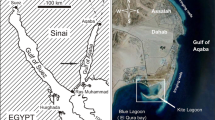Abstract
The Hawaiian vermetid fauna comprises 8 species, 7 of which are here described as new. The generic distribution includes 5 species of Dendropoma and 1 each of Petaloconchus, Vermetus and Serpulorbis. The species descriptions rely little on conchology, stressing instead descriptions of animals, habitats and reproductive and developmental characteristics. Feeding is accomplished in all species by a combination of mucous nets and detrital collection by ctenidial cilia. Only in the single species of Vermetus, an inhabitant of quiet waters, does ciliary feeding predominate. Four small species of Dendropoma inhabit shallow, coralline algal-encrusted, wave-washed reef areas, while Serpulorbis and Dendropoma platypus are found not only in intertidal areas subjected to heavy surf, but subtidally to depths of 10 m or more. The single species of Petaloconchus is a characteristic associate of the 4 Dendropoma spp. of shallow waters but, being strongly associated with the coral Porites, Petaloconchus also extends subtidally. The Hawaiian vermetids are very abundant in some localities, with densities ranging up to 60,000/m3 in one species of Dendropoma. Reproduction is continuous in all Hawaiian vermetids, most of which produce small hatching juveniles rather than swimming veligers. Only Serpulorbis and Vermetus have obligatory planktonic stages. Petaloconchus and Dendropoma species may produce a mixture of hatching juveniles and short-term planktonic veligers. Larval or juvenile size is correlated with available nurse yolk, not with egg size.
Similar content being viewed by others
Literature cited
Cranwell, L. M. and L. B. Moore: Intertidal communities of the Poor Knights Islands, New Zealand. Trans. Proc. N. Z. Inst. 67, 375–403 (1938).
Crossland, C.: The oecology and deposits of the Cape Verde marine fauna. Proc. zool. Soc. Lond. 170–186 (1905).
Habe, T.: Studies on the eggs and larvae of Japanese gastropods. Publs Seto mar. biol. Lab. 3, 161–167 (1953).
Hadfield, M. G.: The reproductive biology of the California vermetid gastropods Serpulorbis squamigerus (Carpenter, 1957) and Petaloconchus montereyensis. Doctoral dissertation, Stanford University. 174 pp. (1966).
—: Observations on the anatomy and biology of two California Vermetid gastropods. Veliger 12 (3), 301–309 (1970).
Keen, A. M.: Vermetid gastropods and marine intertidal zonation. Veliger 3 (1), 1–2 (1960).
—: A proposed reclassification of the gastropod family Vermetidae. Bull. Br. Mus. nat. Hist. (Zool.) 7, 183–213 (1961).
— and J. E. Morton: Some new African species of Dendropoma (Vermetidae: Gastropoda). Proc. malac. Soc. Lond. 34 (1), 36–51 (1960).
Kempf, M. and J. Laborel: Formations de vermets et d'algues calcaires sur les côtes du Brasil. Recl Trav. Stn mar. Endoume 43 (59), 9–23 (1968).
Lacaze-Duthiers, M.: Mémoire sur l'anatomie et l'embryogénie des vermets. Annls Sci. nat. (Zool.) 13, 209–296 (1860).
Morton, J. E.: The structure and adaptations of the New Zealand Vermetidae. Parts I–III. Trans. Proc. R. Soc. N. Z. 79, 1–51 (1951).
—: Form and function in the evolution of the Vermetidae. Bull. Br. Mus. nat. Hist. (Zool.) 11, 585–630 (1965).
Safriel, U.: Recent vermetid formation on the Mediterranean shore of Israel. Proc. malac. Soc. Lond. 37, 27–34 (1966).
Schmidt, W. J.: Nahreter bei miozanen Vermetidae. Paläont. Z. 28, 167–171 (1954).
Stephenson, T. and A. Stephenson: The Bermuda Islands. Endeavour 13 (50), 72–80 (1954).
Thorson, G.: Reproductive and larval ecology of marine bottom invertebrates. Biol. Rev. 25, 1–45 (1950).
—: Zur jetzigen Lage der marinen Bodentier-Okologie. Verh. dt. zool. Ges. Wilhelmshaven 1951, 276–327 (1952).
Yonge, C. M.: Notes on feeding and digestion in Pterocera and Vermetus, with a discussion on the occurrence of the crystalline style in the Gastropoda. Scient. Rep. Gt Barrier Reef Exped. 1, 259–281 (1932).
— and E. J. Iles: On the mantle cavity, pedal gland, and evolution of mucous feeding in the Vermetidae. Ann. Mag. nat. Hist. (Ser. 11) 3, 536–556 (1939).
Author information
Authors and Affiliations
Additional information
Communicated by J. Bunt, Miami
Contribution No. 374 from the Hawaii Institute of Marine Biology, University of Hawaii, Honolulu, Hawaii.
Rights and permissions
About this article
Cite this article
Hadfield, M.G., Kay, E.A., Gillette, M.U. et al. The vermetidae (Mollusca: Gastropoda) of the Hawaiian Islands. Marine Biology 12, 81–98 (1972). https://doi.org/10.1007/BF00347431
Accepted:
Issue Date:
DOI: https://doi.org/10.1007/BF00347431




